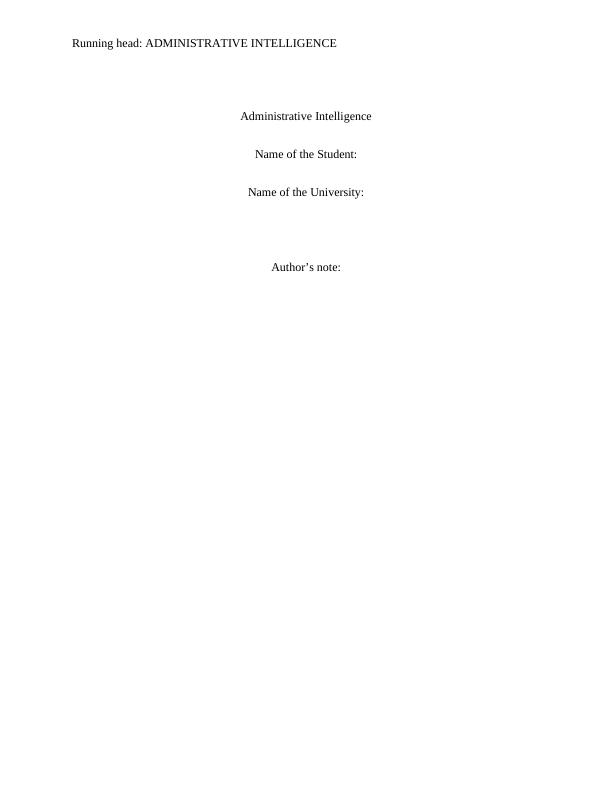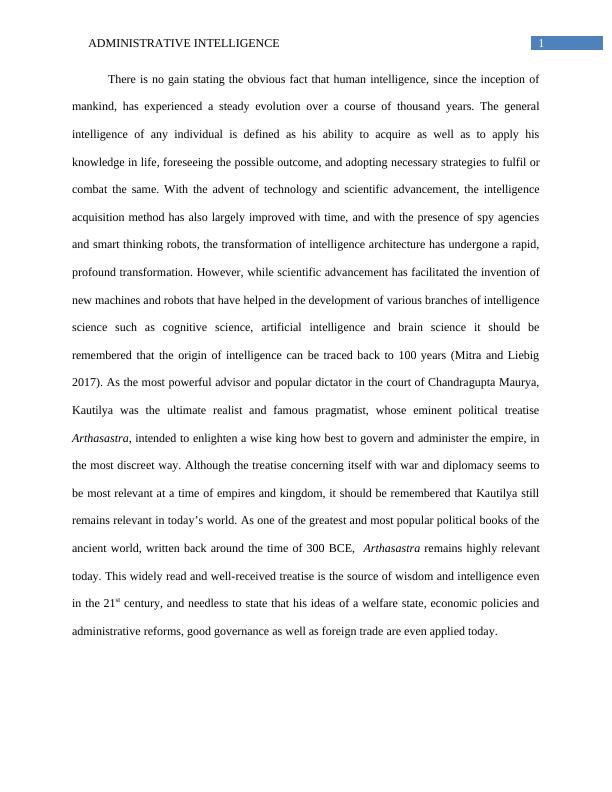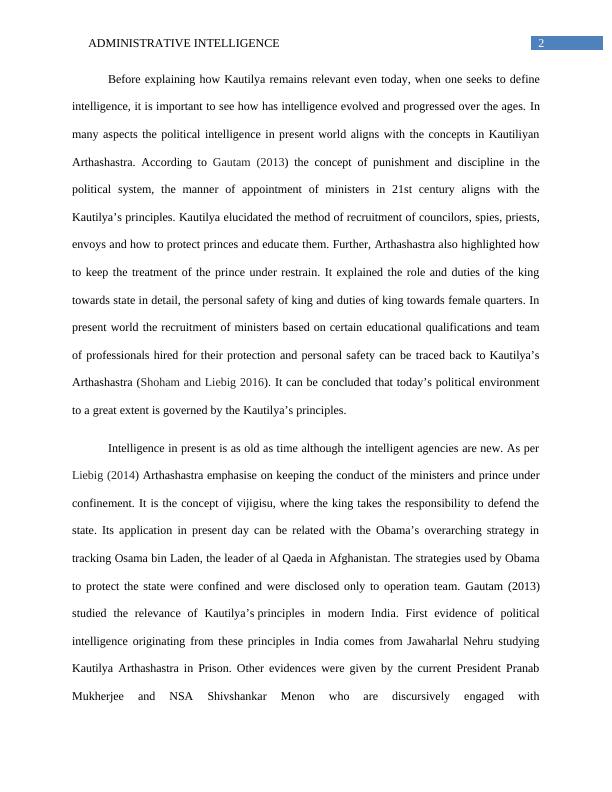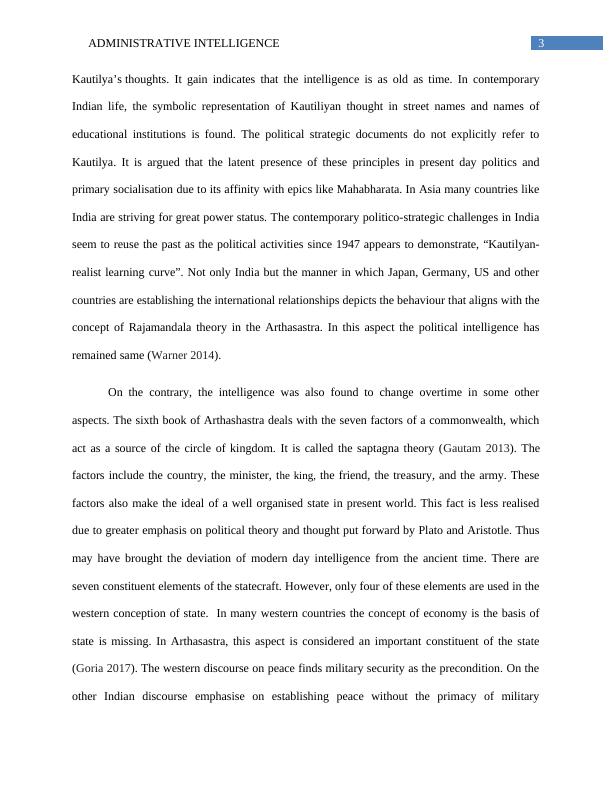Ask a question from expert
Report on Administrative Intelligence
15 Pages4695 Words99 Views
Added on 2020-04-29
Report on Administrative Intelligence
Added on 2020-04-29
BookmarkShareRelated Documents
Running head: ADMINISTRATIVE INTELLIGENCE Administrative IntelligenceName of the Student:Name of the University:Author’s note:

1ADMINISTRATIVE INTELLIGENCEThere is no gain stating the obvious fact that human intelligence, since the inception ofmankind, has experienced a steady evolution over a course of thousand years. The generalintelligence of any individual is defined as his ability to acquire as well as to apply hisknowledge in life, foreseeing the possible outcome, and adopting necessary strategies to fulfil orcombat the same. With the advent of technology and scientific advancement, the intelligenceacquisition method has also largely improved with time, and with the presence of spy agenciesand smart thinking robots, the transformation of intelligence architecture has undergone a rapid,profound transformation. However, while scientific advancement has facilitated the invention ofnew machines and robots that have helped in the development of various branches of intelligencescience such as cognitive science, artificial intelligence and brain science it should beremembered that the origin of intelligence can be traced back to 100 years (Mitra and Liebig2017). As the most powerful advisor and popular dictator in the court of Chandragupta Maurya,Kautilya was the ultimate realist and famous pragmatist, whose eminent political treatiseArthasastra, intended to enlighten a wise king how best to govern and administer the empire, inthe most discreet way. Although the treatise concerning itself with war and diplomacy seems tobe most relevant at a time of empires and kingdom, it should be remembered that Kautilya stillremains relevant in today’s world. As one of the greatest and most popular political books of theancient world, written back around the time of 300 BCE, Arthasastra remains highly relevanttoday. This widely read and well-received treatise is the source of wisdom and intelligence evenin the 21st century, and needless to state that his ideas of a welfare state, economic policies andadministrative reforms, good governance as well as foreign trade are even applied today.

2ADMINISTRATIVE INTELLIGENCEBefore explaining how Kautilya remains relevant even today, when one seeks to defineintelligence, it is important to see how has intelligence evolved and progressed over the ages. Inmany aspects the political intelligence in present world aligns with the concepts in KautiliyanArthashastra. According to Gautam (2013) the concept of punishment and discipline in thepolitical system, the manner of appointment of ministers in 21st century aligns with theKautilya’s principles. Kautilya elucidated the method of recruitment of councilors, spies, priests,envoys and how to protect princes and educate them. Further, Arthashastra also highlighted howto keep the treatment of the prince under restrain. It explained the role and duties of the kingtowards state in detail, the personal safety of king and duties of king towards female quarters. Inpresent world the recruitment of ministers based on certain educational qualifications and teamof professionals hired for their protection and personal safety can be traced back to Kautilya’sArthashastra (Shoham and Liebig 2016). It can be concluded that today’s political environmentto a great extent is governed by the Kautilya’sprinciples.Intelligence in present is as old as time although the intelligent agencies are new. As perLiebig (2014) Arthashastra emphasise on keeping the conduct of the ministers and prince underconfinement. It is the concept of vijigisu, where the king takes the responsibility to defend thestate. Its application in present day can be related with the Obama’s overarching strategy intracking Osama bin Laden, the leader of al Qaeda in Afghanistan. The strategies used by Obamato protect the state were confined and were disclosed only to operation team. Gautam (2013)studied the relevance of Kautilya’sprinciples in modern India. First evidence of politicalintelligence originating from these principles in India comes from Jawaharlal Nehru studyingKautilya Arthashastra in Prison. Other evidences were given by the current President PranabMukherjee and NSA Shivshankar Menon who are discursively engaged with

3ADMINISTRATIVE INTELLIGENCEKautilya’sthoughts. It gain indicates that the intelligence is as old as time. In contemporaryIndian life, the symbolic representation of Kautiliyan thought in street names and names ofeducational institutions is found. The political strategic documents do not explicitly refer toKautilya. It is argued that the latent presence of these principles in present day politics andprimary socialisation due to its affinity with epics like Mahabharata. In Asia many countries likeIndia are striving for great power status. The contemporary politico-strategic challenges in Indiaseem to reuse the past as the political activities since 1947 appears to demonstrate, “Kautilyan-realist learning curve”. Not only India but the manner in which Japan, Germany, US and othercountries are establishing the international relationships depicts the behaviour that aligns with theconcept of Rajamandala theory in the Arthasastra. In this aspect the political intelligence hasremained same (Warner 2014). On the contrary, the intelligence was also found to change overtime in some otheraspects. The sixth book of Arthashastra deals with the seven factors of a commonwealth, whichact as a source of the circle of kingdom. It is called the saptagna theory (Gautam 2013). Thefactors include the country, the minister, the king, the friend, the treasury, and the army. Thesefactors also make the ideal of a well organised state in present world. This fact is less realiseddue to greater emphasis on political theory and thought put forward by Plato and Aristotle. Thusmay have brought the deviation of modern day intelligence from the ancient time. There areseven constituent elements of the statecraft. However, only four of these elements are used in thewestern conception of state. In many western countries the concept of economy is the basis ofstate is missing. In Arthasastra, this aspect is considered an important constituent of the state(Goria 2017). The western discourse on peace finds military security as the precondition. On theother Indian discourse emphasise on establishing peace without the primacy of military

End of preview
Want to access all the pages? Upload your documents or become a member.